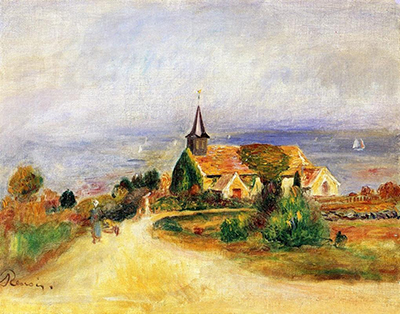A painting believed to have been created in 1889. The painter was inspired by the impressionism style during the rejection of impressionist period
The 33 by 41cm landscape painting made on canvas using oil as a medium depicts the painter’s personality in various ways.
The Village by the Sea represents the painter’s eye for beauty. Although the painting is presented as a ‘village’, it appears as though it is a settlement or a beach community next to the clear background of calm sea waters.
When looked at keenly, it is as though Renoir aimed at making the big church-like structure the painting’s centre of attention. When looking at the painting, a person first sees the massive structure than the small surrounding houses before he notices the person moving towards the village and the sea in the background.
Interestingly, other than the title of the painting, one sees the town is next to the sea because of the boats floating in the background. The colour meant to depict the sea is not as conspicuous.
The warm colours used are useful in creating a work that suits the style and period in which this painting was created. Renoir, like other artists such as Camille Pissaro, Edouard Manet, Berthe Marisot and Alfred Sisley, created images that depicted everyday life.
Whether one sees the church-like structure or the houses surrounding it, they are structures common in any community. The woman heading towards the building could either be going home or to the church. Whichever it may be, she is doing something that is a routine to every other person in a community.
The achievements of the impressionists, particularly with their attention to colour, would later bring about the Fauvists, spearheaded by Henri Matisse. His most famous paintings included Dance, Snail and Goldfish.
Evidently, the warm colours used evoke warmth in the audience as they are a representation of familiarity, which was an objective for painters during that period. Renoir appears to have applied different amounts of brush strokes pressures at various aspects of the painting not only to show that this was daytime but also summertime.
Furthermore, through the use of light shades at the foreground and focal point, while using darker tones in the background, the painter draws attention to the settlement rather than the serenity of the sea. He influences the audience to focus on the stable aspect of a home and the road leading to it rather than focusing on the calm waters which may become unstable at any moment.
Village by the Sea is similar to other paintings such as “Camille Monet and her Son Jean in the Garden Argenteuil” and “The Large Bathers” which he created in 1874 and 1877, respectively. In all these paintings, Renoir uses warm oil colours to depict a scenario that is familiar to the ordinary person in his/her everyday life.
By focusing on the painting’s focal point, one can see Renoir’s appreciation for beauty and the essential things in life. Additionally, the painting is not only appealing but also easy to the eye. Whether one likes art or not, this work will interest them.




